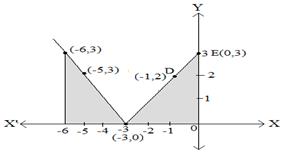Ask questions which are clear, concise and easy to understand.
Ask QuestionPosted by Muskan Goyal 6 years, 2 months ago
- 0 answers
Posted by Krishna Umre 6 years, 2 months ago
- 0 answers
Posted by Sk Babu 6 years, 2 months ago
- 1 answers
Posted by Mitrasen Tiwari 6 years, 2 months ago
- 0 answers
Posted by Nitesh Kumar 6 years, 2 months ago
- 1 answers
Sanjay Kumar 6 years, 2 months ago
Posted by Vidushi Mishra 6 years, 2 months ago
- 1 answers
Posted by Aman Khan 6 years, 2 months ago
- 1 answers
Posted by Nishi Dubey 6 years, 2 months ago
- 0 answers
Posted by Sanjeet Kumar 6 years, 2 months ago
- 5 answers
Ron Vineetahuja 6 years, 2 months ago
Posted by Ravi Yadav 6 years, 2 months ago
- 0 answers
Posted by Naidu Ganesh 6 years, 2 months ago
- 1 answers
Sia ? 6 years, 2 months ago
y = |x + 3|
{tex} \Rightarrow y = \left( {x + 3} \right){/tex}, {tex}if\ x\geq-3{/tex}
y = -(x + 3), if x < -3
{tex}\int_{ - 6}^0 {\left| {x + 3} \right|dx = ?} {/tex}
Area {tex}= \int_{ - 6}^{ - 3} {-\left( {x + 3} \right)dx + \int_{ - 3}^0 {\left( {x + 3} \right)dx} } {/tex}
{tex}= \left[ {-\frac{x^2}{2}-3x} \right]_{-6}^{-3}+ \left[ {\frac{x^2}{2}+3x} \right]_{-3}^{0}{/tex}
{tex}= \left[ {(-\frac{9}{2}+9)-(-\frac{36}{2}+18)} \right]+ \left[ {(0+0)-(\frac{9}{2}-9)} \right]{/tex}
{tex}= \left[ {(\frac{9}{2}+0)+(0+\frac{9}{2})} \right]{/tex}
= 9 sq units

Posted by Oru Pavam Padippi 6 years, 2 months ago
- 1 answers
Shreyansh Jain 6 years, 2 months ago
Posted by Oru Pavam Padippi 6 years, 2 months ago
- 0 answers
Posted by Dj . 6 years, 2 months ago
- 1 answers
Sia ? 6 years, 2 months ago
Each ring can be worn on any of four fingers and this can be done in 5 ways.
Hence, the required number of ways = (4)5.
Posted by Shruti Omar 6 years, 2 months ago
- 2 answers
Anshul Sharma 6 years, 2 months ago
Posted by Bhwirab Mochahary 6 years, 2 months ago
- 0 answers
Posted by Ankini Nema 6 years, 2 months ago
- 2 answers
Shikha Maurya 6 years, 2 months ago
Prince Maurya 6 years, 2 months ago
Posted by Ankini Nema 6 years, 2 months ago
- 1 answers
Vishakha Dhiman 6 years, 2 months ago
Posted by Prince Rathore 6 years, 2 months ago
- 1 answers
Posted by Shikha Maurya 6 years, 2 months ago
- 1 answers
Posted by Shruti Nigam 6 years, 2 months ago
- 0 answers
Posted by Rajkumar Bansal 6 years, 2 months ago
- 1 answers
Posted by Pooja Bhakar 6 years, 2 months ago
- 0 answers
Posted by Isha Jamnal 6 years, 2 months ago
- 1 answers
Archana Goel 6 years, 2 months ago
Posted by Sakshi Ranjan 6 years, 2 months ago
- 0 answers
Posted by Rizwana Multani 6 years, 2 months ago
- 1 answers
Arpita Sharma 6 years, 2 months ago
Posted by Saboor Ahmad 6 years, 2 months ago
- 1 answers
Sia ? 6 years, 2 months ago
Given: The diagonals of a parallelogram are equal.

To prove: Parallelogram is a rectangle.
Proof : In {tex}\triangle{/tex}ACB and {tex}\triangle{/tex}BDA,
AC = BD . . . [Given]
AB = BA . . . [Common]
BC = AD . . . [Opposite sides of parallelogram]
{tex}\therefore{/tex} {tex}\triangle{/tex}ACB {tex}\cong{/tex}{tex}\triangle{/tex}BDA . . .[By SSS property]
{tex}\therefore{/tex} {tex}\angle{/tex}ABC = {tex}\angle{/tex}BAD . . . [c.p.c.t.] . . . .(1)
As AD || BC . . . [Opposite sides of parallelogram]
transversal AB intersects them.
{tex}\therefore{/tex} {tex}\angle{/tex}BAD + {tex}\angle{/tex}ABC = 180o . . . [Sum of interior angle on the same side of a transversal] . . . .(2)
{tex}\angle{/tex}BAD = {tex}\angle{/tex}ABC = 90o . . . [From (1) and (2)]
{tex}\therefore{/tex} {tex}\angle{/tex}A = 90o
{tex}\therefore{/tex} Parallelogram ABCD is a rectangle.
Posted by Priyanshu Asthana 6 years, 2 months ago
- 0 answers

myCBSEguide
Trusted by 1 Crore+ Students

Test Generator
Create papers online. It's FREE.

CUET Mock Tests
75,000+ questions to practice only on myCBSEguide app
 myCBSEguide
myCBSEguide